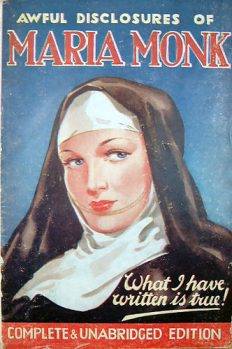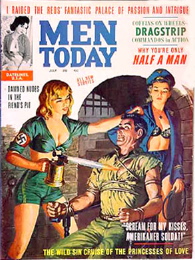In my research, I’ve observed patterns in the past that we still see today.

For instance, in the 1830s, a woman named Maria Monk turned up in New York City. She claimed that she had been held prisoner as a sex slave in a convent in Montreal, where she had been subjected to bizarre tortures and told to sexually serve the priests who entered the convent via an underground tunnel. Any offspring of these unions would be baptized, strangled and disposed of in lime pits.
In a nation full of anti-Catholic and nativist ideologies, Monk’s (probably ghost-written) book, Awful Disclosures of Maria Monk, became a bestseller. Problem was, when people investigated the convent in Montreal, they could find no evidence Monk had ever been there, no tunnels, no lime pits, and none of the bizarre torture devices she described.
Awful Disclosures remained a staple of anti-Catholic propaganda, even during the presidential campaign of John F Kennedy. Anti-Catholicism frequently traded in sexual imagery, linking religious deviance (from sober Protestantism) with sexual deviance. This contributed to the rise of “sexy nun” erotica.
This eroticization wasn’t unique to anti-Catholicism.
In the decades leading up to the US Civil War, northerners and abolitionists painted the slaveholding South as a hotbed of sexual impropriety. This slid into eroticization, both before and after the war, leading to books like Memoirs of Dolly Morton, which purported to be a white woman’s story of being held effectively as a slave.

In antebellum New Orleans, the house of socialite Delphine Lalaurie was destroyed in a fire, which revealed the bodies of tortured slaves. Over time, this incident has grown into legend, depicting Lalaurie as a witch with insatiable and perverse sexual appetites. In the exploitation film, Goodbye Uncle Tom, Lalaurie was played by a beautiful woman slinking around her manor in a see-through nightie, standing over a pile of naked slaves drugged with opium.

In an era that professed the idealization of women as pure and chaste and maternal, there was nothing more terrifying than a sexually aggressive woman. The existence of a woman like the mythologized Lalaurie was the symptom of the deviance and depravity of the South. It was also, for certain people, sexually arousing.
Even in the 19th century, militarism and authoritarian regimes were linked with sexual deviance. Starting in the 1930s, fascism was strongly associated with homosexuality, fetishism, sadism and masochism.

After WWII, American men’s adventure magazines created an iconography of male and female sadists wearing swastikas, titillating with the promise of sadism and aggressive women.

Starting with Love Camp 7 in 1969, we had the beginnings of the Nazisploitation subgenre of film. This included highbrow dramas like Cabaret and The Night Porter, and grindhouse classics like Ilsa, She Wolf of the SS in 1975. Dyanne Thorne played Ilsa (very loosely based on real world wife of a camp commandant, Ilse Koch), the icy blonde mistress of bizarre medical experiments, who takes male prisoners to her bed for one night, then has them castrated.

Despite dying at the end of the film, Ilsa returned in Ilsa, Harem Keeper of the Oil Sheiks, now working for petro-states and not having aged a day. Thorne also played a similar character in two more unofficial sequels, Ilsa, the Tigress of Siberia and Ilsa, the Wicked Warden.
Even if she dies at the end of the film, Ilsa always comes back, off to serve some other regime: Stalinst gulag, North American mafia, or Latin American dictatorship. The “Nazi dominatrix” archetype, both terrifying and titillating, can be attached to any politically deviant regime. Only a truly corrupt society could produce such an unwomanly woman.
And this is still happening.
The “Satanic panic” of the 1980s, alleging ritualized sexualized abuse of children, deployed the same tropes of strange abuse, hidden realms of tunnels and secret rooms, etc.
During the 2016 US Presidential election, there was the Pizzagate conspiracy theory, alleging the Democratic Party leadership ran a secret child prostitution/pornography ring out of a hidden secret room underneath a pizza parlor in Washington DC. This would be ridiculous if not for the fact that at least one person believed it enough to enter the restaurant and fire off a gun.
Even more recently, there’s the “Frazzledrip” theory. This claims that there’s a snuff video circulating in the dark web which shows Hillary Clinton and her right hand woman, Huma Abedin, mutilating and killing children in a Satanic ritual. The alt-right types who have spread this story have picked up on the idea of portraying Clinton as the “evil woman” archetype, just like Ilsa, Delphine Laulaurie, and the other monster women. It never gets old.




[…] Emmanuelle (1974), and edgier material like Nazisploitation classics The Night Porter (1974), Ilsa: She-Wolf of the SS (1975) and Salon Kitty (1976). (I’ve heard that Damiano wanted to film Story of O but couldn’t get the […]